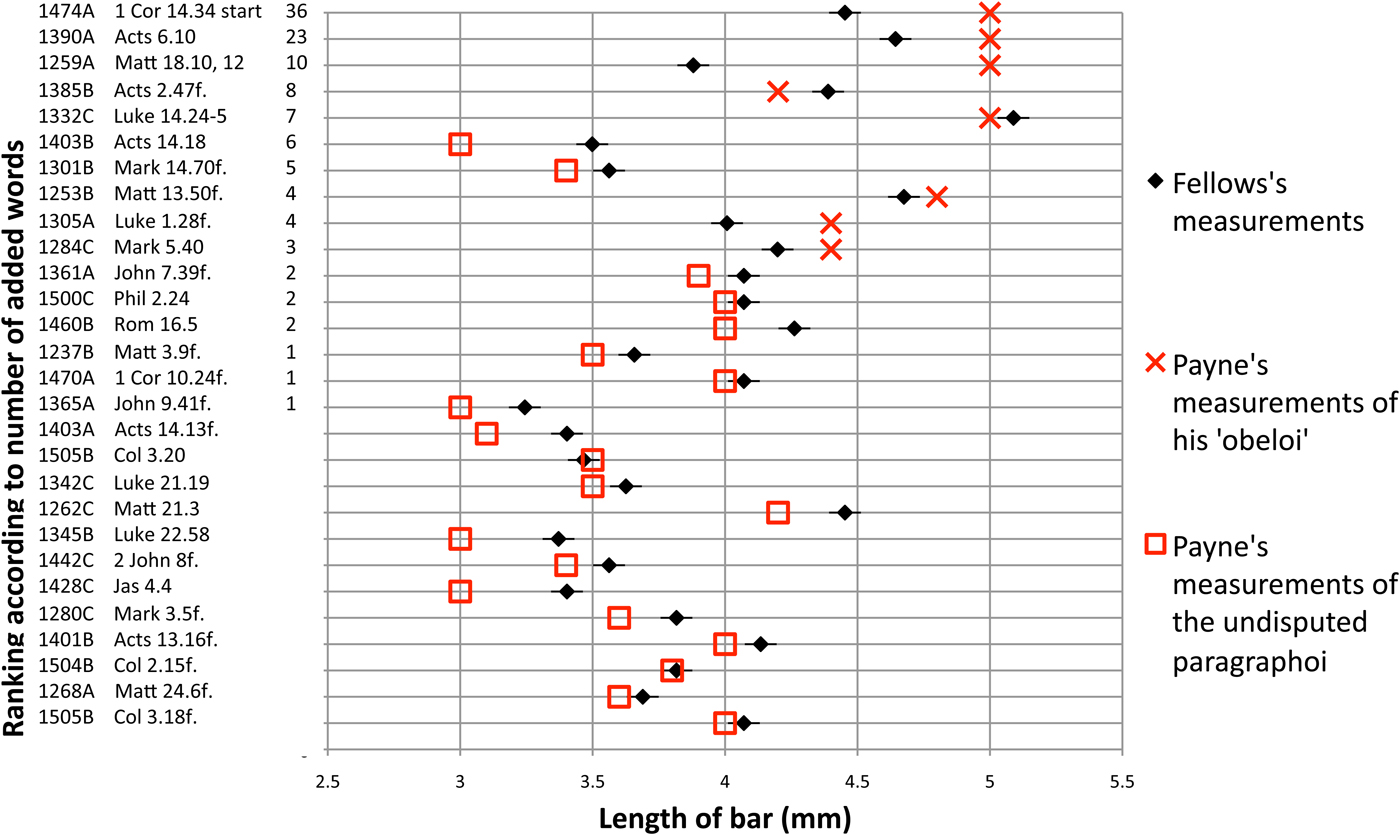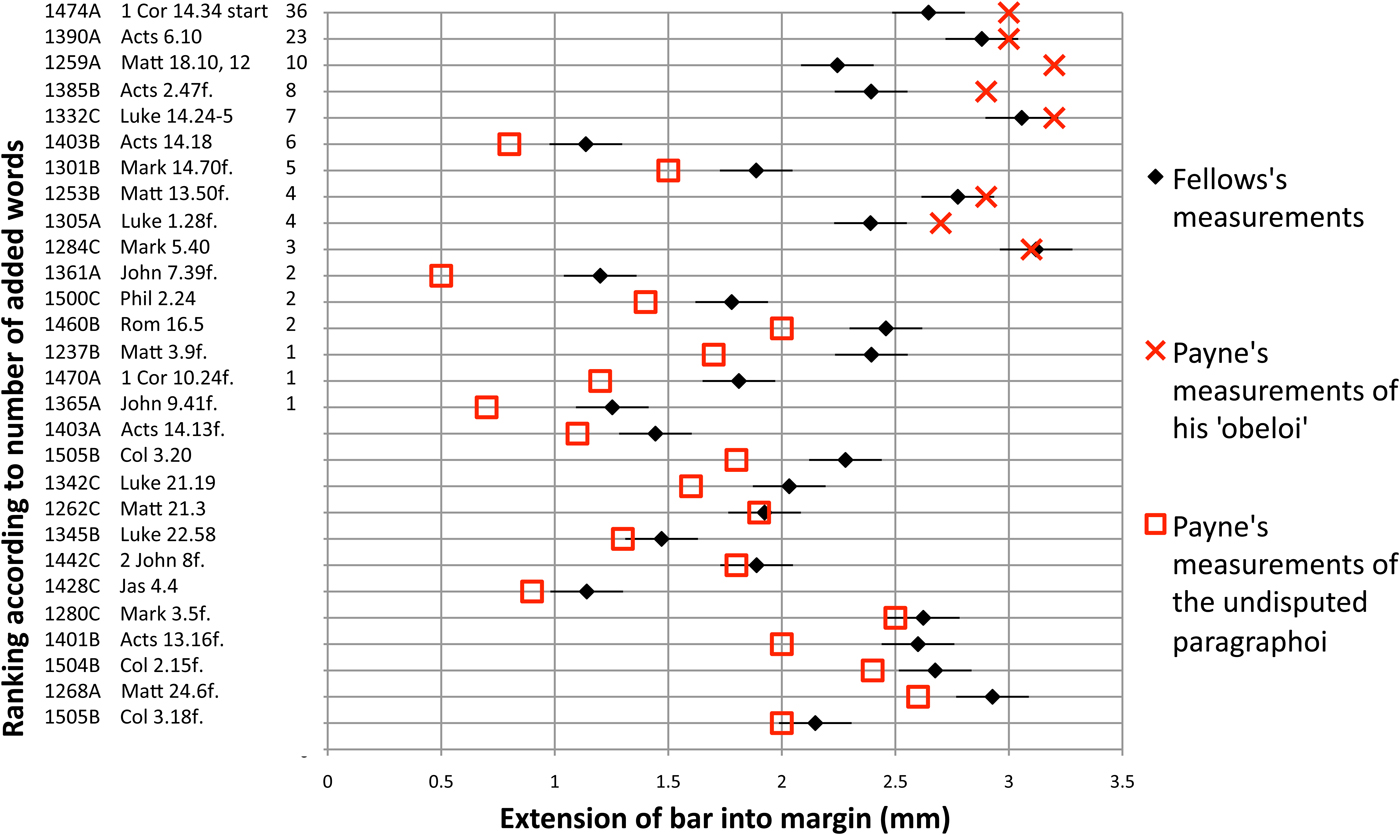1 Cor 14.34–5 seems to forbid women from speaking in church. These verses appear immediately after 14.40 in the Western tradition (D F G 88* a b d f g Ambrosiaster Sedulius-Scotus). This fact, along with other evidence, has led many to see the infamous text as a non-Pauline addition that perhaps originated as a note in the margin.Footnote 1
Codex Vaticanus contains numerous pairs of dots in the margin, sometimes referred to as ‘distigmai’. There are also many horizontal bars, known as ‘paragraphoi’, which indicate divisions into sense units. Sometimes a distigme occurs at the same location as a horizontal line. In a recent paper in this journal Philip Payne counted twenty-eight such cases, one of which appears at the start of 1 Cor 14.34 and is shown in Fig. 1.Footnote 2 In eight of the twenty-eight cases, including 1 Cor 14.34, the horizontal bar is not a mere paragraphos, according to Payne, but is an ‘obelos’ and indicates the existence of textual variants that have added text. Payne uses the term ‘distigme-obelos’ to describe these eight combinations of the pair of dots and the horizontal line. He believes that the ‘distigme-obelos’ symbols were made by the original scribe and that the one at 1 Cor 14.34 indicates that the scribe saw 14.34–5 as an interpolation. Thus he supports the view that these verses were not written by Paul. The crux of Payne's argument is that in eight cases, including 1 Cor 14.34, the horizontal line contains features that distinguish it from a normal paragraphos.

Figure 1. Image of the distigme and bar at the end of 1 Cor 14.34. The image is taken from Payne's article.
The present article does not address the question of whether Paul silenced women at 1 Cor 14.34–5, or even whether he wrote the text. Our purpose is merely to examine whether measurements of the horizontal lines confirm Payne's assertion that some of them are more than mere paragraphoi. He claims that the eight lines are ‘graphically different in two respects from the Vaticanus paragraphoi’, and explains that ‘[g]reater extension into the margin is their primary graphic distinction, but they also average 4.7 mm long compared to the remaining twenty bars’ 3.6 mm average length’.Footnote 3 Let us then look in turn at their extension into the margin and their length.
1. Extension into margin
The extension into the margin of the twenty-eight Vaticanus bars adjacent to distigmai are shown in Fig. 2. They are ranked according to the largest number of words of added text in textual variants in NA28. The Vaticanus page numbers and columns are also shown. The crosses and squares indicate Payne's measurements.Footnote 4 It can be seen that the extensions into the margin do not show a bimodal distribution. Payne's case that the bars belong to two distinct types therefore hangs on his observation that there is a correlation between extension into the margin and the presence of multi-word variants. If Payne's measurements were correct there would indeed be a strong correlation, because the eight bars with the greatest extension into the margin (shown as crosses) are all associated with multi-word textual variants. However, he has made systematic measurement errors. My own measurements are shown as black diamonds with error bars.Footnote 5 Payne's measurements are smaller than mine for all twenty undisputed paragraphoi (shown as squares). His measurements of all but one of his eight ‘obeloi’ are greater than mine. There can be no systematic bias in my own measurements because I made them without knowing which bars were at locations of multi-word variants. That is to say, when I made the measurements I did not know which bars were among the eight claimed by Payne to be obeloi and which were the undisputed paragraphoi. Thus, the systematic differences between Payne's measurements and mine cannot be explained by his use of different photographs or his use of a different measurement technique. Readers can easily check the measurements themselves.Footnote 6 Looking, then, at the black diamonds, it can be seen that there is no strong correlation between extension into the margin and the number of words of omitted text in textual variants. Any trend is explicable by chance. Payne states that his eight supposed obeloi ‘protrude into the margin, on average, 3.0 mm compared to a sharply contrasting 1.6 mm for the twenty undisputed paragraphoi’.Footnote 7 With my measurements, on the other hand, the numbers are 2.69 mm and 1.95 mm, which is not ‘sharply contrasting’. Furthermore, the greater margin intrusion of Payne's eight ‘obeloi’ proves nothing on its own since he has selected them for their greater margin intrusion!

Figure 2. Bar extensions into the margin.
There is a dot preceding the bar at Matt 18.10, 12 and Payne has included it as part of the bar. I do not include it because it adds little to the visible impression of length.
There is also an attempted bar adjacent to a distigme at 1285B (Mark 6.11). This case was overlooked by Payne, and the bar is hard to spot because it was inked successfully only at its extreme ends. Our conclusions would not change if we included this bar in the analysis or if we included the dot at Matt 18.10, 12.
Payne writes: ‘The characteristic bar adjacent to a distigme at the interface of 1 Cor 14.33 and 34 extends 3 mm into the margin. In contrast, the seventy-five other bars in 1 Corinthians extend, on average, 2 mm into the margin, and only one of these seventy-five extends 3 mm into the margin’.Footnote 8 However, I find seventeen bars in 1 Corinthians that have greater extension into the margin than that at the start of 1 Cor 14.34.Footnote 9
2. Length
Again Payne's numbers show systematic measurement bias. His measurements of all but one of the undisputed paragraphoi are smaller than mine. His length measurements are greater than mine for six of the eight ‘obeloi’. While he gave his measurements in millimetres to one decimal place, the data suggest he had a clear preference for whole numbers of millimetres, since thirteen of his twenty-eight lengths are integers. He has rounded up the length of the bar at the start of 1 Cor 14.34 to 5.0 mm, and he rounded up its intrusion into the margin to 3.0 mm.
As mentioned above, I excluded the possibility of bias by making these measurements without knowledge of the textual variants corresponding to each bar (see Fig. 3). It can be seen that with these unbiased results there is no strong correlation between bar length and number of added words in textual variants. The bar at the start of 1 Cor 14.34 is not at all exceptional in its length. There are about thirteen bars in 1 Corinthians that are measurably longer.Footnote 10

Figure 3. Bar lengths.
It is true that the bar at the start of 1 Cor 14.34 is longer than the average bar and extends further into the margin than the average bar. However, it should be pointed out that these are not two independent observations: the bar is longer than average precisely because it extends further into the margin.
Payne chose to compare measurements of his eight ‘obeloi’ with those of the twenty undisputed paragraphoi that also have distigmai. There are two problems with this approach. Firstly, it is misleading because the eight ‘obeloi’ have been ‘cherry-picked’ because of their measurements (the bars at Acts 14.18, Mark 14.70, John 7.39 etc. are excluded from the eight). Secondly, he chooses to compare his ‘obeloi’ against only the undisputed paragraphoi that have adjacent distigmai. It would be better to compare all sixteen bars associated with textual variants that have added text (the sixteen cases at the top of Fig. 3) with all other paragraphoi. Time does not allow me to do that but I can report that, by my measurements, the sixteen cases at the top of Fig. 3 have an average length of 4.11 mm, and the seventy-four paragraphoi in 1 Corinthians (other than that at 14.34) have an average length of 4.01 mm, which is virtually the same.
Conclusion
The bar at the start of 1 Cor 14.34 is indistinguishable from other paragraphoi. Payne's counter-arguments result from errors of measurement and method.Footnote 11








